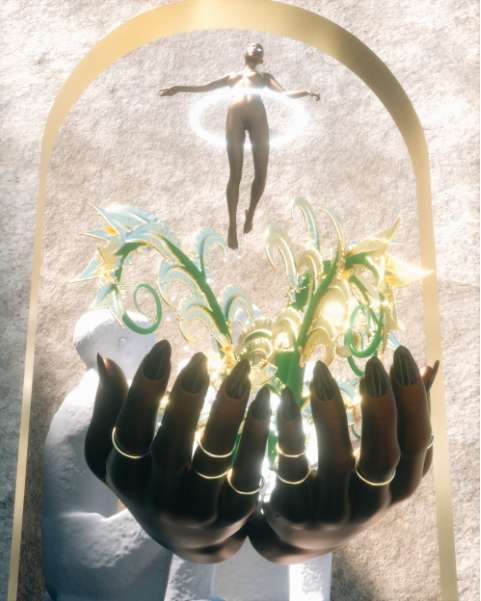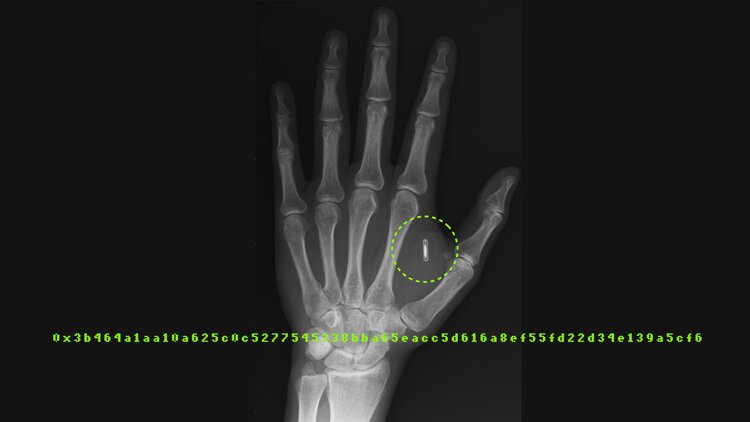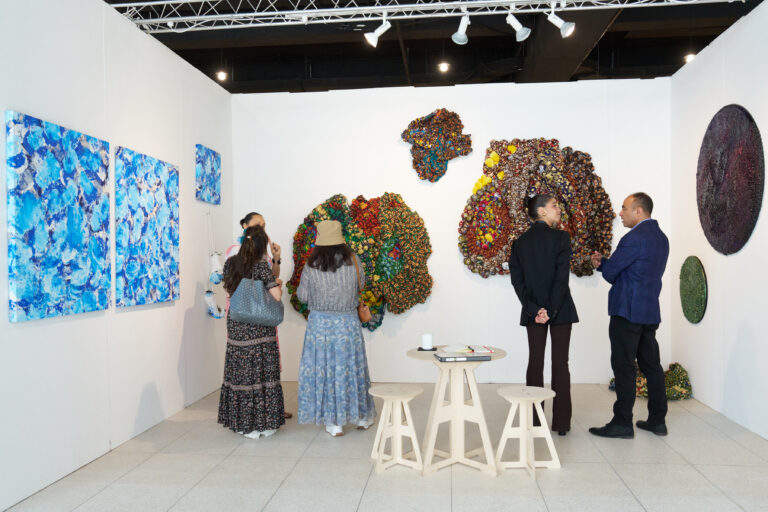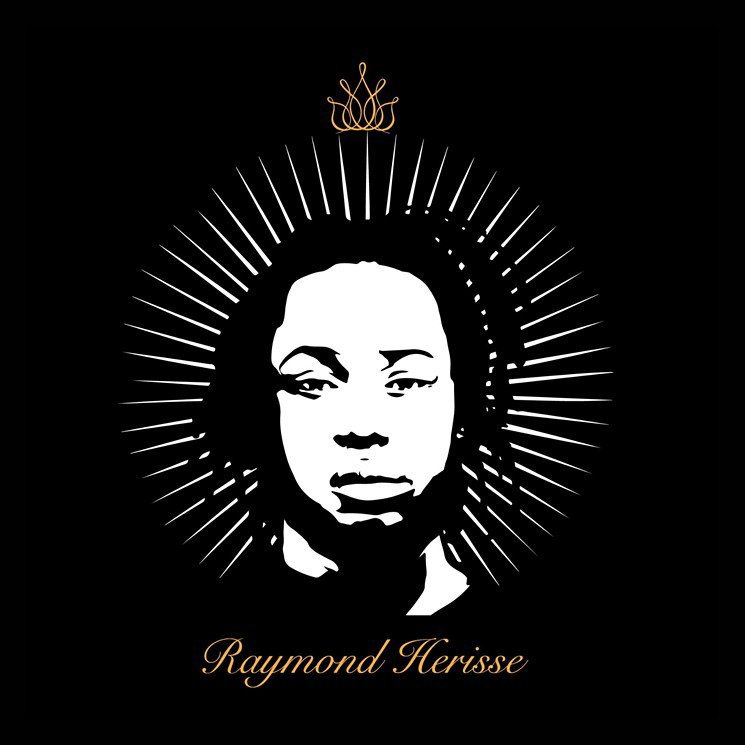For those who feel most comfortable in virtual worlds, the sale and procurement of digital assets including rare collectibles and NFTs (non-fungible tokens), is a prevailing lifestyle—a means through which to champion a creative community that is often ignored. Speculation about and valuation by cultural institutions including museums, commercial galleries and auction houses about what mediums and which artists should be collected is systemically biased. The canon is rife with deficits—overt and subtle omissions that skew our collective cultural memories and obscure divergent art forms. The narrow classification systems that those institutions engage always have been slow to embrace emerging media and even slower to recognize non-white creatives.

Above: G.R.O.W. [Night] (Still) by Andre Oshea
Digital artists are the underdogs in the contemporary art world. In the metaverse, a universe of virtual domains, and a catchall terminology for an ever-expanding blockchain ecosystem, digital artists are king. Nerdy creatives who can build and exhibit immersive virtual worlds, collectibles, static and moving-image artworks are finding great success exchanging those works for crypto currencies. Minting art as an NFT—a non-fungible token that archives essential provenance associated with the work—allows others in the metaverse to procure and hold the digital asset in their personal encrypted wallets.
Though this movement has been quietly thriving for more than a decade, until recently, common knowledge about NFTs and the metaverse has remained relatively obscure. Christie’s $69 million mega sale of the controversial artist Beeple’s Everyday’s The First 5,000 Days, an arguably pseudo NFT, to crypto afficionados, Vignesh Sunaresan aka Metakovan and Anand Venkateswaran aka Twobadour, brought national attention to the otherwise lesser-known token. Now artists, art institutions and investors are scrambling to learn more about how to mint their own NFTs and cash in on what they presume will continue to be a bullish market.
There are plenty of reasons to be critical about the limits of Web 3, crypto and NFTs. Collectibles and blockchain artworks have no physicality, a reality that is more of a burden for older generations to understand than it is for Millennials and Gen-Z-ers who have adapted to and vastly evolved the hybridity of virtual and IRL (in real life) landscapes.
“I have brothers that play Fortnite all the time,” notes xx1OFF cofounder Herman Marigny IV. “They buy their skins, they don’t want the skins anywhere else but in the game. They’re completely fine with in-game assets.”
xx1OFF is one of the first galleries in the metaverse that explicitly curates digital art works minted as NFTs created by Black-identifying artists. This year, they launched the exhibition, Beyond Provenance: Speculative $Black Futures on the Blockchain on Cryptovoxels, a virtual blockchain world, and have hopes of expanding their virtual gallery into a multifacility district for Black creatives on the blockchain.

Above: Wild Ridge Mountain B by Andre Oshea
“What we did was figure out how to warm people up to spaces by starting with something that seemed very familiar,” Marigny shared. “[We] filled the walls with Black art, heavy on figuration, because letting Black people see themselves in the metaverse is super important, and then presented it in a traditional gallery structure, [but] everything was digital. People are not foreign to virtual museum experiences. The only thing that would be different is when you went to click the art, it would bring you into these marketplaces, and that’s kind of where the story starts to unfold.”
Marigny and his partner Brandon Bailey are more hopeful than they are skeptical about the possibilities that Web 3 and NFTs present for Black creatives. “I fell into the rabbit hole of blockchain [and asked] what does it mean specifically for disruption in the financial system?” Marigny continued. “When we came across NFTs, it felt like this really great alignment. It opened up this opportunity for artist-run environments in terms of them having access to those secondary market sales and the opportunity that presented for generational wealth to be accumulated.”
In addition to the exhibition, xx1OFF also released a white paper that articulated the value that Black artists on the blockchain had accrued from their digital transactions. “It was really to illustrate that you weren’t just exchanging dollars for depreciating in art or dollars for depreciating assets,” Marigny clarified, “you were sharing a digital asset that will grow in value. The value will fluctuate over time as an investment, it’s not predictable, but beyond that, you can take what you have earned and then you could borrow against this asset. You can use your art, your creativity to earn an asset and open up access to capital.”

Above: 5th Element B by Andre Oshea
“This is an opportunity to empower the Black community through this new tech,” Bailey affirmed. “What that means from the standpoint of being able to earn secondary incomes or to earn royalties from secondary sales, or what that means for families who can earn an asset that appreciates has huge implications. Coming from a finance background, we understand the difficulty that our community has had with getting access to credit and capital.”
There may be more advantages for creators than for collectors, who will have to grapple with a harsh 28% tax on assets; a new condition of the 1031 art exchange tax code. Despite this, many of the digital artists and collectors operating in the metaverse emphasize innovation, sovereignty, equity and economic empowerment as major merits of the decentralized exchanges that are possible through the blockchain.
Web 3 and NFTs allow direct communication between creators and the market; an accessibility pipeline that displaces art and music industry gatekeepers, corporations and institutional middlemen. For die-hard believers, the utopian possibilities that the metaverse offers remain a guiding principle for the movement. Thoughtful creatives are optimistic that these technologies will be leveraged not only to support underrepresented artists but also be used for the betterment of humankind.
“Often what we do benefits the whole, but we haven’t received that back; there’s been no real reciprocation in that regard,” digital artist, podcaster and prolific curator Lady Phe0nix noted about histories of Black innovation. The meta-hyphenated visionary who describes themselves as “working at the intersections of art and technology,” is passionate about elevating historically underrepresented communities in dynamic ways in the metaverses of Web3.
“We as dominant people on the planet and as indigenous people to planet Earth deserve to be at the forefront of all technological advances,” Lady Phe0nix went on. “The metaverse is not new. When I would be in the prayer revival with my grandmother overnight, those prayer revivals were the metaverse. The metaverse is essentially an agreement that people hold, and part of that agreement is just imagining the creation of a new space that we can have together. People put their minds together to create a new energy or new space or vortex for us to all make something manifest; whether it be healing or prosperity, or a job, or a baby… Anything was possible.

Above: Wild Ridge Mountain A by Andre Oshea
“That’s why representation is really important,” they continued, “because we also need to work with indigenous wisdom, understanding that wisdom is a type of technology.” Lady Phe0nix has been a prominent advocate for knowledge sharing between younger artists and older creatives. She coined the term Audio Reactive NFT and was a major facilitator in efforts to get honorary artworks for the estate of jazz musician Thelonious Monk and legendary Funk icon Bootsy Collins minted as Legacy NFTs. Bootsy’s NFT, Crypto Funk sold for 17.5 Ethereum, the equivalent of U.S. $34,822.
“We have to, much in a tradition of our people, continue this intergenerational conversation,” Lady Phe0nix noted, “which is why I continue to bring our ancestors and our elders into the future with us [and] to make sure we’re going hand-in-hand to this new promised land of the metaverse. I don’t think it’s actually the promised land, I think it’s just more of the same with the better graphics card, but we can’t really be dropping an NFT in a serious way if we’re not allowing a type of creative reparation for our elders.”
As a curator, Lady Phe0nix remains a powerful innovator. Notable interventions include Crypto Basel, Crypto Fashion Week and exhibits at Yes Universe and Universe Contemporary, a metaverse gallery. On April 5, Lady Phe0nix will launch Meta_VS, which they describe as being a “combination between traditional contemporary art form and the blockchain and digital art ethos.” Those who register for the exclusive launch will gain access to rare, limited edition digital art works that are backed by NFTs and the blockchain.
Exclusive drops are essential marketing tools for digital artists and major selling points for popular marketplaces like Nifty Gateway, SuperRare and Foundation. Drops ensure that the community of artists and collectors that privilege one marketplace over another will have first dibs on newly minted exclusive content. It is likely that the next wave of crypto marketplaces will include more tightly curated releases, and this feature could prompt higher price points for starting bids. The dream that many Web3 creatives hold about the equalizing economic potential of decentralized marketplaces clashes with the scarcity model of cryptocurrencies and the walled-garden limitations of marketplaces operating on Web 3.
Will crypto marketplaces operate more like elite IRL auction houses instead of the inclusive platforms that bullish blockchain advocates proselytize the technology will evolve into? The paradox triggers important questions about the future of accessibility into blockchain marketplaces.

Above: Reflection B by Andre Oshea
It’s worth noting that many of the platforms operating on Web3 are entirely open-source, which means top layers of the code can be replicated and represented on other platforms. This feature makes it easier for creatives to render their own NFT galleries and crypto marketplaces. A dynamic feature of the technology is that you don’t really need to use any of the established marketplaces to sell your NFTs. When you mint an NFT or establish a digital wallet, you are given a distinct shareable address that allows anyone to view and purchase that content directly from the creative no matter where it resides in the metaverse.
However, high gas fees, a charge incurred by artists to pay miners for the computing power needed to confirm the transaction, may continue to be too cost prohibitive for many newbies entering the market. The emergence of blockchain domains operated by singular artists or smaller art collectives are likely to become more common as well. Artist owned and operated blockchain domains maintain the ethos of the decentralized market, eliminate gatekeepers and offer a direct artist to collector pipeline.
“Sometimes as a pioneer, if you’re a trendsetter, if you’re a visionary investor, you may be ahead of the curve. So, I was like, you know what, I’m gonna just do my own thing,” said ADOR Finance Coin and XFA network Director and consultant Mark Savage. ADOR is a new decentralized finance (DEFI) token, that is built on the Ethereum blockchain. XFA is the platform that hosts marketplace exchanges that use the ADOR token.
“This entire industry is still in beta,” Savage continued, “and I knew that I had to do my own platform; create a door to bring diversity and inclusion. As a lead manager, I think about what I can bring to the space that is innovative, different, what people want and what the artists want. But now with NFTs, we can combine art and music and performance, and that’s when you can get mass adoption, that’s when people can resonate with a story.”

Above: G.R.O.W. [Day] (Still) by Andre Oshea
Savage is dedicated to creating pathways for underrepresented communities to have a foundational stake in a new decentralized token, from mining to saleable digital assets. “We are limitless,” Savage offered, “We limit ourselves. So as we step into that exponential growth, that exponential mindset, then we can [truly] create. I’m not coming from a place of lack, I’m coming from a place of abundance, and I’m going to see this entire industry grow. I use my knowledge to help others, so that it’s kind of this reciprocal loop that I’m manifesting.”
A primary concern for many collectors of digital art assets is that the presentation layer of NFTs can be copied and represented as a new identical work of art. This oversight adds to the skepticism of many critics about the exorbitant valuation of NFTs; artworks that many pundits equate to memes; basic JPEGs and GIFs that anyone could steal by invoking the function “right-click, save as.” It is important to note that only the top layer; the image or animation, is copiable, but not the provenance that is locked into the distinct hash address assigned to the NFT. This is perhaps the strongest feature of the technology; it offers a mechanism by which to ensure authenticity while also logging data into a built-in registry that tracks all asset exchanges. The provenance is locked into the original asset.
Hackers are masters of adaptation and it is rumored that the presumably impenetrable, decentralized market exchange is not as secure as many proclaim it to be. Blockchain innovators, including Lady Phe0nix and others are working to devise strategies to safeguard the personal data and digital assets of current and future blockchain stakeholders.
As we continue to assert that Black people will continue to exist in the future, and foster pipelines to insert Black creatives into the blockchain, artists are also troubling the dystopian potential of these emerging technologies. Multidisciplinary artist Lans King biohacked his own body into a case study and cautionary signal about the looming advancement of surveillance technologies.
King turned himself into an NFT by surgically inserting a microchip capsule into his hand. The microchip, which King notably describes as “uncomfortable,” is linked to an NFT that collects his biometric data and information about his location. As a conceptual artwork and a feasible resource for a police state to employ, King’s actions are arguably triggering; the long history of experimentation on indigenous, Black, Jewish and LatinX communities, as well as the troubling history of chattel slavery of Africans, makes one question why anyone would voluntarily undergo such a procedure.

Above: Lans King
“It as though I’m using myself as a guinea pig,” King responded. “[This is] perhaps a way of raising awareness that, in the near future, these microchips are likely to become obligatory. We may be required to implant some tech like this for our identification, payment systems and passports. With regards to my private data in the NFT, we already give much of our information to corporations through our social media and mobile phones.” King, who adamantly noted that he is an extremely private person, willingly tokenized his body in ways that the most perverse speculative fiction has already envisioned. The shadow implications for the tokenizing and sale of humans in a decentralized market is deeply disconcerting.
It is only in recent history that Black memory and achievement have been deemed worthy of archival projects. The surge in digital asset acquisitions that features Black cultural achievements as minted NFTs—NBA Top Shot collectibles is a prominent example of one such major marketplace—parallel looming questions in the traditional art market about whether the original arbiters of the content, or the likenesses on which the content is based, will see any of the proceeds of the sale or resale of the collectible tokens. Even in a decentralized world, the commoditization of Black bodies remains a taboo conversation. It is not hard to imagine that more stringent protections eventually will be put in place, not by choice, but because young Black and Brown creatives, predominant innovators of trendworthy digital countercultural movements/moments, will force platforms to enforce equity. If artist sovereignty over the artwork in the metaverse is the emancipating pronouncement of Web3, it surely will be Black creatives on the blockchain who will push to secure the sustained realization of that creed.









